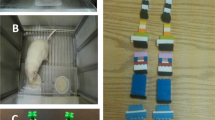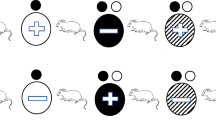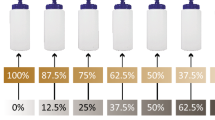Abstract
Adults were trained on a matching-to-sample task which initially involved matching either familiar, distinctive odor stimuli (smells) or less familiar, less distinctive stimuli (perfumes) with nonsense syllables (A→B training). If they met a criterion of successful performance, they were transferred to a task where they had to match nonsense syllables to line drawings (B→C training). Following successful performance, there was a test phase where the line drawings were presented as samples with the odors as comparison stimuli (C→A test phase). All participants who successfully completed A→B training also successfully completed B→C training, and 12 out of 14 selected the correct comparison stimuli on 100% of C→A test trials, with one further participant achieving 97% success. This indicates that stimulus equivalence class formation had occurred, where one element of each stimulus class was an olfactory stimulus. Some participants failed to complete A→B training successfully in the more difficult perfumes condition. This is consistent with literature from other learning paradigms. These findings have extended the generality of stimulus equivalence class formation and have implications for the role of verbal labeling. This experiment also adds significantly to the growing body of recent literature which indicates similarities between olfactory memory and that involving other modalities.
Similar content being viewed by others
References
ANNETT, J. M. (1993). Effects of visual and verbal suppression on olfactory memory. Unpublished D. Phil thesis, University of Ulster.
BUSH, K. M. (1993). Stimulus equivalence and cross-modal transfer. The Psychological Record, 43, 567–584.
DAVIS, R. G. (1975). Acquisition of verbal associations to olfactory stimuli of varying familiarity and to abstract visual stimuli. Journal of Experimental Psychology: Human Learning and Memory, 1, 134–142.
DAVIS, R. G. (1977). Acquisition and retention of verbal associations to olfactory and abstract visual stimuli of varying similarity. Journal of Experimental Psychology: Human Learning and Memory, 3, 37–51.
DEGRANDPRE, R. J., BICKEL, W. K., & HIGGINS, S. T. (1992). Emergent equivance relations between interoceptive (drug) and exteroceptive (visual) stimuli. Journal of the Experimental Analysis of Behavior, 58, 9–18.
DUBE, W. V., GREEN, G., & SERNA, R. W. (1993). Auditory successive conditional discrimination and auditory stimulus equivalence classes. Journal of the Experimental Analysis of Behavior, 59, 103–114.
DUGDALE, N., & LOWE, C. R. (1990). Naming and stimulus equivalence. In D. E. Blackman & H. Lejeune (Eds.), Behaviour analysis in theory and practice. Hove: Lawrence Erlbaum.
ENGEN, T. (1982). The perception of odors. New York: Academic Press.
ENGEN, T., KUISMA, J. E., & EIMAS, P. D. (1973). Short-term memory for odors. Journal of Experimental Psychology, 99, 222–225.
ENGEN, T., & ROSS, B. M. (1973). Long-term memory of odors with and without verbal descriptions. Journal of Experimental Psychology, 100, 221–227.
GOYOS, C., DUGDALE, N., & LOWE, C. R. (1991). Equivalence class formation via common reinforcers: The role of naming. Poster presented at the Association of Behavior Analysis, Atlanta, GA. May, 1991.
HAYES, L. J., THOMPSON, S., & HAYES, S. C. (1989). Stimulus equivalence and rule following. Journal of the Experimental Analysis of Behavior, 52, 275–291.
HAYES, L. J., TILLEY, K. J., & HAYES, S. C. (1988). Extending equivalence class membership to gustatory stimuli. The Psychological Record, 38, 473–482.
HAYES, S. C., & HAYES, L. J. (1992). Verbal relations and the evolution of behavioral analysis. American Psychologist, 47, 1383–1395.
LESLIE, J. C. (1993). The kraken wakes: Behaviourism in the twenty-first century. Irish Journal of Psychology, 14, 219–232.
LESLIE, J. C., TIERNEY, K. J., ROBINSON, P., KEENAN, M., WATT, A., & BARNES, D. (1993). Differences between clinically anxious and non-anxious subjects in a stimulus equivalence training task involving threat words. The Psychological Record, 43, 153–161.
LYMAN, B. J., & MCDANIEL, M. A. (1990). Memory for odors and odor names: Modalities of elaboration and imagery. Journal of Experimental Psychology: Learning, Memory and Cognition, 16, 656–664.
PERKINS, J., & MCLAUGHLIN COOK, N. A. (1990). Recognition and recall of odours: The effects of suppressing visual and verbal encoding processes. British Journal of Psychology, 81, 221–226.
RABIN, M. D., & CAIN, W. S. (1984). Odor recognition: familiarity, identifiability and encoding consistency. Journal of Experimental Psychology: Learning, Memory and Cognition, 10, 316–325.
SCHUSTERMAN, R. J., & KASTAK, D. (1993). A Californian sea lion (Zalophus californianus) is capable of forming equivalence relations. The Psychological Record, 43, 823–839.
SIDMAN, M. (1990). Equivalence relations: Where do they come from? In D. E. Blackman & H. Lejeune (Eds.), Behaviour analysis in theory and practice. Hove: Lawrence Erlbaum.
SIDMAN, M., WILLSON-MORRIS, M., & KIRK, B. (1986). Matching to sample procedures and the development of equivalence relations: The role of naming. Analysis and Intervention in Developmental Disabilities, 6, 1–19.
WATT, A., KEENAN, M., BARNES, D., & CAIRNS, E. (1991). Social categorization and stimulus equivalence. The Psychological Record, 41, 33–50.
WULFERT, E., DOUGHER, M. J., & GREENWAY, D. E. (1991). Protocol analysis of the correspondence of verbal behavior and equivalence class formation. Journal of the Experimental Analysis of Behavior, 56, 489–504.
Author information
Authors and Affiliations
Rights and permissions
About this article
Cite this article
Annett, J.M., Leslie, J.C. Stimulus Equivalence Classes Involving Olfactory Stimuli. Psychol Rec 45, 439–450 (1995). https://doi.org/10.1007/BF03395153
Published:
Issue Date:
DOI: https://doi.org/10.1007/BF03395153




